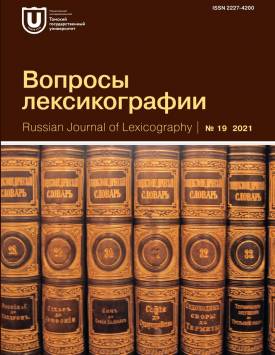Lexical-Grammatical Status and Lexicographic Presentation of Two-Component Stable Prepositional Combinations
The aim of the article is to review the ways of dictionary presentation of stable prepositional combinations and the factors essential for their lexical-grammatical status and the type of optimal lexicographic description. The object of the study is two-component prepositional combinations with stable meanings and the “preposition+noun” structure. The material of the article is data of different dictionaries of Russian presenting stable prepositional combinations. In the course of the study, the following questions were answered: why the definition and interpretation of the lexical-grammatical nature of stable prepositional combinations are so difficult and ambiguous; what lexicographic interpretation these units have in dictionaries of different types; what the advantages and disadvantages of different ways of dictionary interpretation of such language material are. The following methods were used: introspective (observation, generalization, classification), systematic lexicographic description according to dictionary parameters, dictionary definition analysis. The summary table of the lexicographic presentation of stable combinations allows seeing both the unresolved question of dictionary interpretation of such units and the patterns of their interpretation depending on the type of a dictionary. As a result of the analysis the following conclusions were drawn. 1) In modern Russian there is a rather large (about 2,000 units) class of language units (prepositional combinations), the lexical-grammatical status of which is not defined, and there is no term for their definition; this class is historically formed and continues to replenish. 2) The type of dictionary presentation of stable prepositional combinations is determined by the dictionary concept, grammatical and syntactic properties, presence of figurative meaning and possibility of component variation of such combinations. 3) The unresolved theoretical issues have as a result the lexicographic discrepancy in the presentation of these language units. Extreme lexicographic solutions are a separate dictionary entry for each combination and the presentation of such units only as stable combinations in the entry of a noun (presented in academic explanatory dictionaries). 4) Taking into account only the factor of presence/absence of a gap seems to formalize the dictionary presentation of adverbs with both conjoined and split spelling, really existing in Russian, and the position of recognition of these units with independent words and their isolate presentation is not impeccable for dictionary users. 5) In the author’s opinion, the presentation of stable prepositional combinations exclusively as independent vocabules is inferior to the traditional lexicographic approach because the isolated presentation of this material breaks the semantic connections of these complex lexical units; the most complex issue is the differentiation of adverbs with split spelling and stable combinations.
Keywords
explanatory lexicography, phraseological lexicography, phraseology, prepositional combinations, equivalents of wordAuthors
| Name | Organization | |
| Generalova Elena V. | Saint Petersburg State University | elena-generalova@yandex.ru |
References

Lexical-Grammatical Status and Lexicographic Presentation of Two-Component Stable Prepositional Combinations | Voprosy leksikografii – Russian Journal of Lexicography. 2021. № 19. DOI: 10.17223/22274200/19/2
